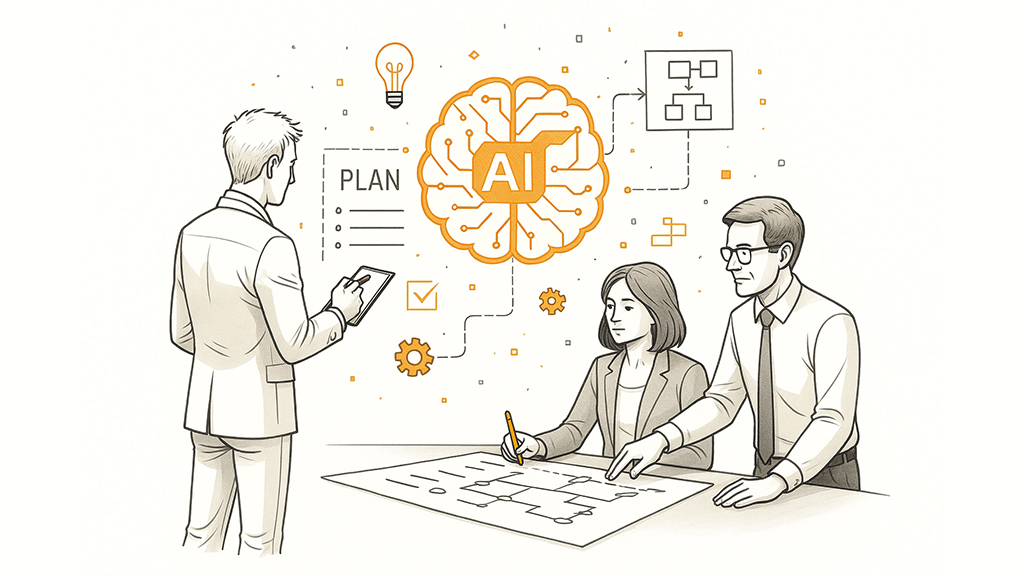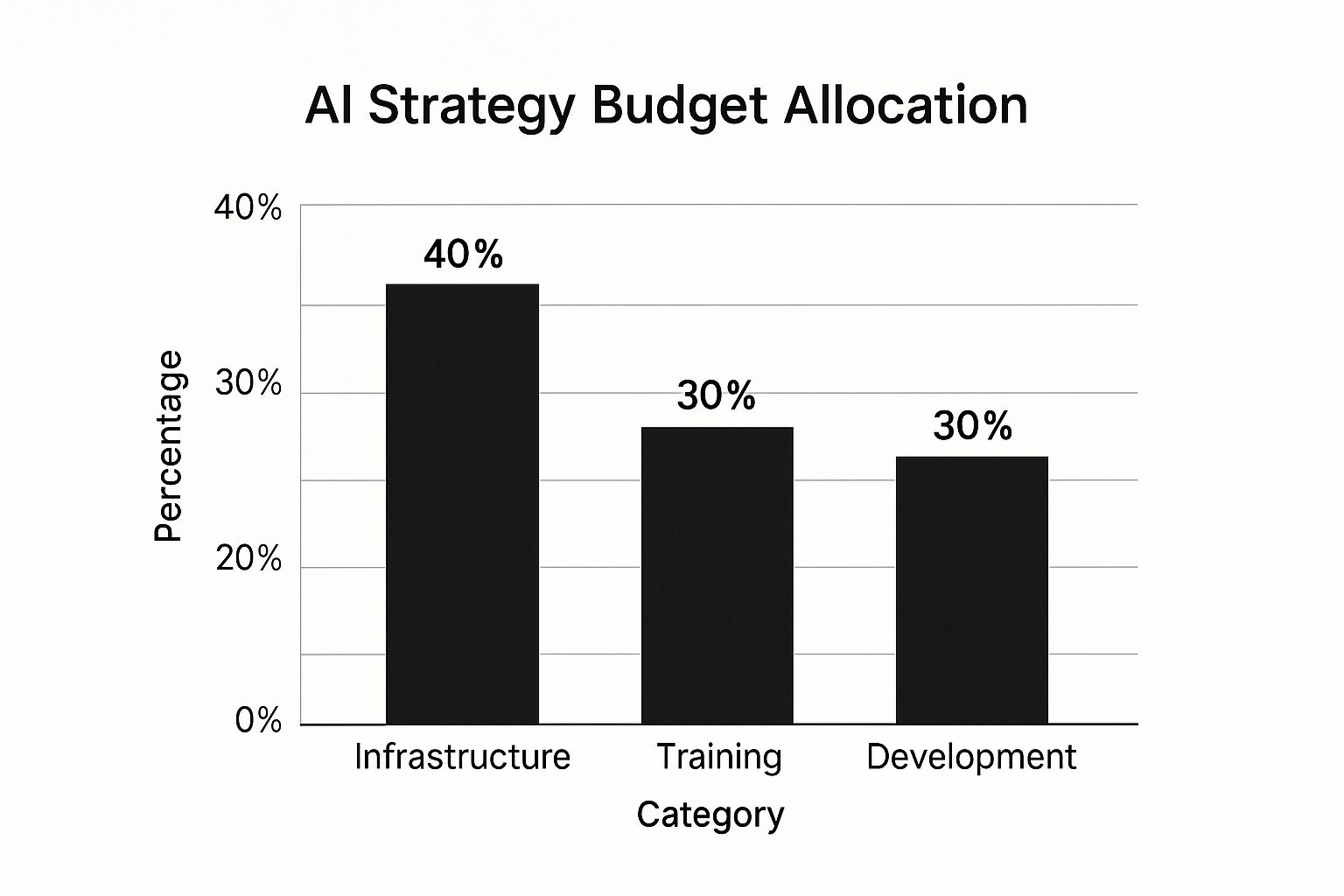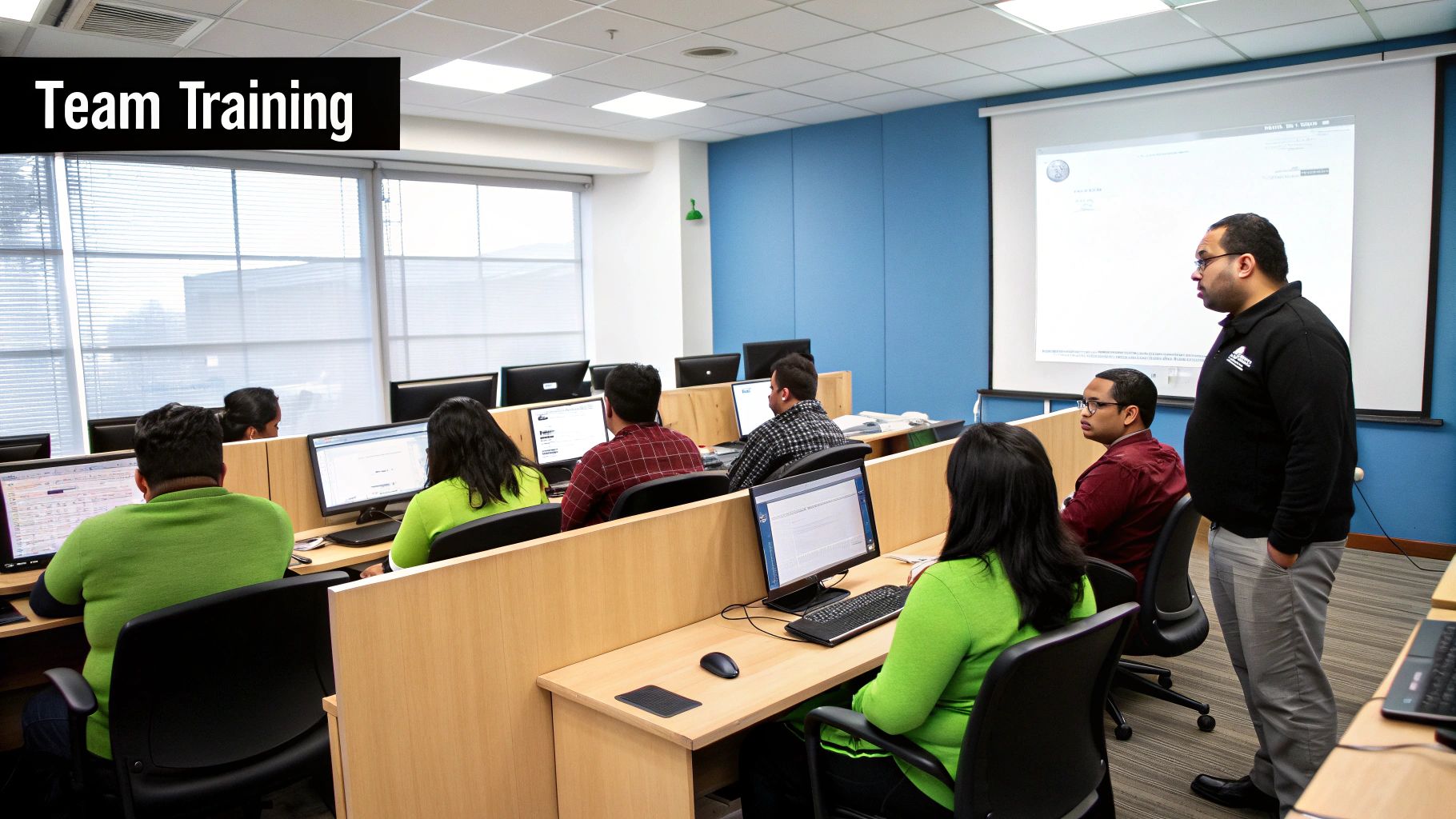How to Adopt AI in Business: Your Reality-Based Action Plan
Master how to adopt AI in business with proven strategies from successful implementations. Get practical steps that drive results, not just theory.

The Real State of AI in Business Today
Let's cut through the noise for a moment. Every business publication and conference speaker is talking about AI, but what does bringing it into your company actually look like on the ground? The reality is far more practical than the headlines suggest. It’s less about futuristic robots and more about using focused tools to solve specific problems and get clear results. Success isn’t just for tech giants with massive budgets; it’s being achieved by regular companies that are strategic, realistic, and focused on creating value.
Forget the idea that you need a perfect, pristine data warehouse to begin. Many leaders I speak with delay their AI journey because they believe they aren't "ready." In truth, the companies making real progress start by acknowledging their current state—messy data and all—and finding a single, high-impact problem to solve. They don’t try to boil the ocean; they start by warming a kettle.
The True Adoption Landscape
AI adoption isn't a single event; it's a gradual process of weaving technology into your operations. The first step for many is automating repetitive tasks to boost efficiency. According to one study, AI and related technologies can automate activities that take up 60% to 70% of employees' time, freeing them to concentrate on more strategic work. This could be something as simple as an AI-powered tool that qualifies sales leads, ensuring your team only spends time on prospects with genuine potential.
This practical approach is driving quick uptake. For instance, Dutch businesses are becoming European leaders, with an adoption rate of 49% expected by 2025, which is well above the European average. A new Dutch company is reportedly starting its AI journey every four minutes, showing just how accessible these tools have become. You can explore the full report on the rapid AI adoption in the Netherlands to see how quickly things are moving.
From Hype to Practical Application
The conversation has thankfully shifted from "What is AI?" to "What can AI do for my business process?" Companies are moving past fascination and towards function. They are using accessible platforms to build real solutions that make a difference.
Here’s a great example of the kind of ecosystem that enables this practical adoption, showing the breadth of available machine learning services.
This shows you don’t need to build everything from scratch. You can pick from a menu of services from providers like Amazon Web Services to address specific needs, such as forecasting or text analysis. The key takeaway is that the barrier to entry has never been lower.
The secret to a successful start lies in this focused, pragmatic mindset. It’s about understanding that the first step in learning how to adopt AI in business isn't a massive technological overhaul. Instead, it’s a strategic decision to solve one problem well. Services that help pinpoint these high-value opportunities are vital for organisations that want to move quickly without the traditional overhead. For those looking to speed up this discovery phase, you can learn more about developing a tailored AI strategy in 24 hours. This reality-based approach is where genuine progress begins.
Honestly Evaluating Your Organisation's Starting Point

Before you get carried away by all the exciting possibilities of AI, it’s crucial to take a moment and honestly look at where your business is right now. This isn't about needing a perfect launchpad; it's about knowing your foundation so you can build on it without everything falling apart later. A successful AI adoption journey starts with a frank self-assessment, not a blind leap of faith. The goal is to get a realistic picture, identify your strengths, and spot the areas that need shoring up before you pour in significant time and money.
This evaluation boils down to four key pillars: your data reality, technology foundation, team capabilities, and organisational culture. Getting this right is the first practical step in figuring out how to adopt AI in business and avoiding predictable headaches.
The Reality of Your Data
Data is the fuel for AI, but the idea of having perfectly clean, centralised data is often just a fantasy. Let’s be real: your data is probably scattered, inconsistent, and incomplete. And that’s perfectly fine. The important question isn’t, "Is our data perfect?" but rather, "Is it accessible and good enough for what we need to do?"
Start by asking a few hard questions:
- Where is our most valuable information? Is it stuck in old legacy systems, spread across different cloud tools, or just sitting in spreadsheets on someone’s laptop?
- What’s the quality like? Do you have common standards for how data is entered, or is it a bit of a free-for-all? I worked with a high-end retailer who found that inconsistent product names between their e-commerce site and inventory system made building a reliable demand forecast impossible. They had to pause and run a simple data standardisation project first—a vital but often skipped step.
- Who is in charge of the data? Understanding data governance is essential. If your marketing team needs to wait three weeks for approval to access sales data, your plan to build a slick, predictive lead-scoring model is dead in the water.
Your Current Technology Foundation
You don't need the latest and greatest tech stack to get started with AI, but you do need to know if your current systems can handle new integrations. A huge roadblock for many companies is rigid, old infrastructure that wasn’t built for the kind of flexibility AI requires. For example, a mid-sized logistics company wanted to use AI for route optimisation but discovered its decade-old fleet management software had no APIs. This made pulling real-time data for the AI model a non-starter.
Your tech check-up should be all about practicality. Can your core systems, like your CRM or ERP, actually talk to external tools? Do you have cloud infrastructure that can handle the heavy lifting an AI model needs? Answering these helps you know if you can begin with a simple plug-in or if you need to budget for a bigger infrastructure project first.
Your Team’s Capabilities and Skill Gaps
Putting enterprise AI into practice is a team effort; it takes more than just a few data scientists. You need a blend of skills, including people who truly get the business problems you’re trying to fix. Research shows that while many executives believe AI delivers better insights, those insights are worthless if nobody on the team knows how to act on them.
A proper skills audit looks beyond just technical know-how:
- Technical Skills: Do you have people who understand data engineering, machine learning, or cloud platforms like Azure or AWS?
- Business Translation: Who can act as a bridge between the tech folks and the business leaders? These "translators" are gold because they make sure AI projects solve actual business problems.
- Change Management: Who will be the champion for the new AI-driven processes and help everyone else adapt their daily work?
Organisational Culture and Mindset
Finally, and this might be the most important part, is your culture ready for AI? AI introduces new ways of working and making decisions. If your organisation resists change, can't tolerate experimentation, or works in rigid silos, your AI projects will face a constant struggle. A culture that embraces learning from failure is much more likely to find success. Is your leadership willing to back pilot projects that might not show immediate ROI but offer priceless learning opportunities?
To help you get a clear picture, we've put together a simple framework. This table allows you to score your organisation across the four pillars and identify what needs to be done.
Assessment Area
Key Indicators
Readiness Level
Priority Actions
Data Reality
Data is siloed, inconsistent, and governance is unclear.
Low (1-3): Significant foundational work needed.
Initiate a data audit. Create a data governance committee. Start small with a data cleansing project for one specific use case.
Data is somewhat accessible with manual effort; some quality standards exist.
Medium (4-6): Ready for pilot projects with some prep work.
Identify 2-3 high-value datasets. Document access protocols. Invest in data quality tools for key systems.
Data is largely centralised, clean, and governed by clear policies.
High (7-10): Ready to scale AI initiatives.
Automate data pipelines. Explore advanced data sources (e.g., unstructured data). Establish a central data platform.
Tech Foundation
Legacy systems with no APIs; on-premise servers with limited capacity.
Low (1-3): Major infrastructure hurdles.
Conduct a tech stack audit. Prioritise modernisation of one key system (e.g., CRM). Explore entry-level cloud services.
Hybrid environment; some core systems are cloud-based and have APIs.
Medium (4-6): Capable of supporting integrated AI tools.
Create an integration roadmap. Test API connections for a pilot project. Assess cloud scalability for AI workloads.
Modern, API-first, cloud-native architecture.
High (7-10): Built for agility and AI integration.
Implement MLOps practices. Explore serverless computing for AI models. Optimise for cost and performance.
Team Capabilities
No in-house data expertise; reliance on general IT.
Low (1-3): Significant skills gap.
Invest in foundational data literacy training for all. Hire or contract one data analyst or "translator."
Some analysts who can work with data; no dedicated AI/ML roles.
Medium (4-6): Potential for upskilling.
Identify and upskill employees with potential. Partner with a consultant for the first AI project. Define roles for an AI team.
Dedicated data scientists, engineers, and business translators.
High (7-10): Strong internal AI talent.
Create a centre of excellence. Foster cross-functional collaboration. Encourage continuous learning and experimentation.
Organisational Culture
Risk-averse, siloed departments, resistance to change.
Low (1-3): Cultural barriers are the primary blocker.
Secure executive sponsorship for one small, low-risk pilot. Share success stories widely. Run workshops on AI's potential.
Open to new ideas but cautious; operates in functional teams.
Medium (4-6): Willing to experiment with clear ROI.
Launch cross-functional pilot teams. Establish metrics that value learning, not just immediate financial return.
Embraces experimentation, data-driven decisions, and collaboration.
High (7-10): Culture is an accelerator for AI.
Empower teams to self-serve with AI tools. Create an "innovation budget" for experimental projects. Celebrate both successes and failures.
This honest look at your organisation's starting point is the foundation of a solid business AI strategy. It's not about passing a test; it's about building a realistic plan that sets you up for long-term, sustainable success.
Finding AI Opportunities That Actually Matter
Now that you have a realistic picture of your organisation’s readiness, it’s time for the exciting part: figuring out where AI can make a genuine difference. This is a critical point where many well-intentioned AI adoption plans go off track. It’s easy to get fascinated by what's technically possible, but real value comes from focusing on what’s strategically valuable. The goal is to identify AI use cases that solve real business problems and deliver a measurable return.
Instead of chasing every new shiny tool, start by methodically looking at your core business processes. Think about the entire customer journey or your end-to-end supply chain. Where are the friction points? Where do your teams spend too much time on repetitive, low-value work? These bottlenecks are often gold mines for AI opportunities.
From Friction Points to High-Impact Use Cases
Let’s get practical. Imagine a retail company where the customer service team is constantly swamped with the same questions about order status. Instead of just hiring more agents, they could set up an AI-powered chatbot to handle these common queries instantly. This would free up the human agents to tackle more complex and emotional customer issues. This is a classic example of using AI not to replace people, but to support and augment their skills.
Similarly, a B2B sales team might be struggling with lead prioritisation, spending hours calling prospects who are not a good fit. A predictive lead-scoring model could be a game-changer here. By analysing historical data on which leads converted, the AI can score new leads in real-time, helping the sales team to focus its energy where it counts. These aren't futuristic ideas; they are real solutions to everyday business challenges. The results speak for themselves: 88% of companies using AI report turnover increases averaging 27%, and 71% see productivity improvements, mainly from better data analysis, automation, and customer service. You can learn more about these AI-driven business gains from a recent study.
Balancing Quick Wins and Long-Term Value
As you compile a list of potential AI use cases, you'll need a way to prioritise them. A common mistake is to only chase the big, transformational projects. While these are important, they take a lot of time and come with significant risk. A much smarter approach is to balance these long-term goals with "quick wins"—smaller, less complex projects that can be implemented faster to build momentum and show immediate value.
To help you organise your thinking, it’s useful to create a priority matrix. This framework allows you to score each potential project based on its expected impact, the effort required, and how well it aligns with your overall business strategy.
AI Use Case Priority Matrix
A decision framework for evaluating and prioritising AI opportunities based on impact, effort, and strategic value
Use Case Category
Implementation Effort
Expected Impact
Strategic Value
Priority Score
Customer Support Chatbot
Low
High
Medium
High
Predictive Lead Scoring
Medium
High
High
High
Automated Inventory Management
High
High
High
Medium-High
Personalised Marketing Campaigns
Medium
Medium
High
Medium
HR Candidate Screening
Low
Medium
Low
Low-Medium
Fraud Detection System
High
High
High
High
This matrix helps you move from a long list of ideas to a focused set of AI opportunities that will truly move the needle for your business. It turns a subjective process into a more data-driven decision.
To guide your planning, also think about your budget allocation. A typical breakdown often looks something like this.

This visual shows that a large chunk of your initial budget will likely go towards building a solid technology foundation. Developing the actual AI solutions and upskilling your team are also significant investments. When assessing projects, always weigh these three factors:
- Business Impact: How much value will this project create? Will it cut costs, boost revenue, or make customers happier?
- Implementation Feasibility: Do we have the data, tech, and skills needed to make this happen realistically?
- Strategic Alignment: Does this project directly support our main business objectives?
Finding that sweet spot between impact, feasibility, and strategy is the key to successfully figuring out how to adopt AI in business. This disciplined approach ensures you invest your resources wisely and get the best possible return.
Creating an AI Roadmap That Survives Reality

Once you've spotted a few high-impact AI opportunities, the temptation is to dive straight into building something. This is a classic misstep. A collection of great ideas isn’t a strategy. To successfully adopt AI in business, you need a roadmap—a clear plan that turns your ambitions into a series of tangible, achievable actions. This isn't just a project plan with dates; it's your guide for navigating the inevitable twists and turns of implementation.
A solid AI roadmap does more than list what you’ll build. It explains why you’re building it, how it will be funded, and what success looks like at every stage. It forces you to make tough decisions, balancing the desire for quick wins with the foundational work needed for long-term growth. Think of it as the architectural blueprint for your enterprise AI goals; without it, you're just stacking expensive bricks and hoping for the best.
Setting Objectives That Align with Business Goals
First things first: connect every potential AI initiative directly to a measurable business outcome. This might sound obvious, but it’s amazing how often it gets missed. A goal like "Implement a customer service chatbot" is too vague. A much stronger objective is, "Reduce customer service response times by 40% and free up agent capacity for complex issues by 25% within six months." This simple reframe is critical. It shifts the conversation from deploying a piece of tech to delivering a business result, which makes getting leadership on board much easier.
Having clear objectives also makes prioritisation a lot simpler. When you're looking at several promising projects, you can ask a straightforward question: which one gets us closer to our most important business goals right now? This ensures your efforts are always strategically focused and delivering the most value.
Developing a Realistic Budget
Budgeting for AI can be tricky because the most obvious costs are just the tip of the iceberg. Yes, you need to account for software licences and development time. But the real costs—the ones that often derail projects—are usually lurking beneath the surface. Your budget needs to be honest and cover the full scope of the project.
Here are a few costs that frequently catch organisations by surprise:
- Data Preparation and Cleansing: Your data probably isn't AI-ready. You'll need to budget for the time and tools required to clean and structure it.
- Integration with Existing Systems: That shiny new AI tool needs to talk to your old CRM or ERP system, and that can be a complex and costly task.
- Ongoing Training and Maintenance: AI models aren't a "set it and forget it" solution. They need to be monitored, retrained, and updated as your business evolves.
- Employee Upskilling: Your team will need training not just on how to use the new tools, but on how to change their workflows and decision-making processes.
A robust budget anticipates these expenses, preventing nasty financial surprises from halting your progress. A good rule of thumb is to add a 15-20% contingency to your initial estimate. This buffer will help cover those unforeseen challenges that always pop up.
Creating Timelines That Allow for Learning
Finally, your AI roadmap needs a timeline that reflects reality. Unlike traditional software projects where the requirements are usually fixed, AI projects are experimental by nature. You're exploring what's possible, and not every experiment will be a home run on the first attempt. Your timeline needs to embrace this. Instead of setting rigid, long-term deadlines, structure your roadmap around shorter, iterative cycles.
Break your plan into phases, starting with a small-scale pilot or a Minimum Viable Product (MVP). The goal of this initial phase isn’t a perfect, full-scale deployment; it’s to learn as quickly and cheaply as possible. Did the model perform as you expected? Did people actually use the new process? What unexpected problems did you run into? The answers to these questions will directly shape the next phase of your roadmap, allowing you to adapt your approach based on real-world feedback. This iterative process is the key to building an AI strategy that can actually survive contact with reality.
Building Your AI Dream Team and Tech Foundation
Your AI roadmap is the blueprint, but now it’s time to bring in the builders and gather the materials. A successful AI project isn't just about clever algorithms; it's about having the right people and technology working in sync. But what does "right" really mean for your business? It’s not a one-size-fits-all situation. The trick is to be deliberate about what you build yourself versus what you get from partners, and to create a tech foundation that supports your goals without needing a blank cheque.
Getting this part right, figuring out how to adopt AI in business, means turning your abstract plans into real assets—both human and technological.
Assembling Your Cast of Characters
An enterprise AI project is never a solo performance. It needs a mix of skills that goes way beyond a single data scientist working in a corner. Think of it like putting together a film crew; you need specialists, but you also need people who can see the big picture and ensure everything connects smoothly.
Here are the key roles you'll need to fill, whether you hire new people, train your current team, or bring in partners:
- The Business Translator: This might be your most important player. This individual has a deep understanding of your business challenges and can explain them to the technical team in a way they understand. They make sure the AI solutions being developed actually solve a real-world problem.
- The Data Engineer: This is the unsung hero of any AI initiative. They are responsible for building the data pipelines, making sure that clean, dependable data is ready for the models. Without them, even the most talented data scientist is completely stuck.
- The AI/ML Specialist: This is your technical expert—the person who designs, builds, and trains the AI models. Their knowledge is critical, but their work is only as good as the data they get and the business problem they’re asked to solve.
- The Change Champion: This person, often from a business department, becomes the advocate for the new AI-driven process. They help their colleagues adjust, gather feedback, and push for adoption on the ground.
Putting these roles together in a cross-functional team is vital. Silos are where AI projects go to fail. Your project team should have members from both business and tech, working together from the very beginning.
Choosing Your Technology Path
Just like with your team, your technology strategy needs to fit your company's current situation and ambitions. You don’t have to build a custom AI platform from the ground up. The market offers a wide range of options, from simple plug-and-play tools to highly customisable platforms.
- Off-the-Shelf AI Tools: These are ready-made solutions for specific tasks, like AI-powered CRMs or customer service chatbots. They are quick to set up and don't require much technical skill, making them perfect for getting some quick wins.
- AI Platforms (PaaS): Services from providers like Google Cloud or Azure give you the building blocks to create more tailored solutions without having to manage the underlying infrastructure. This is a solid middle-of-the-road option for companies with some technical know-how.
- Custom Development: Building your own solutions gives you the most flexibility but also demands the biggest investment in talent and time. This approach is best for core strategic projects where a unique solution can give you a significant competitive edge.
The best choice depends on your specific AI use cases, budget, and the skills you have in-house. Many businesses find a hybrid approach works best, using off-the-shelf tools for common problems while investing in custom builds for areas that are truly unique to their operations. This reflects a wider trend in the Netherlands, where thousands of innovative digital businesses are about 90% more productive than average, mainly because of their smart use of technology. You can learn more about how these Dutch businesses are creating value with technology to see these ideas in action. By right-sizing your team and tech, you create a foundation that can scale with you.
Starting Smart with MVPs That Drive Learning
The most successful ways to bring AI into a business don't start with a massive, high-stakes project. Instead, the smart approach is to start small, learn fast, and grow from there. This is where the idea of a Minimum Viable Product (MVP) becomes your most valuable tool. An AI MVP isn’t about rolling out a flawless, feature-packed solution. It's a targeted, lean version created to do one thing very well: test your biggest assumptions with the least amount of time and money.
Think about it like this: instead of spending six months and a huge budget building a predictive maintenance system for your entire factory, you could begin with an MVP that just monitors a single, essential machine. The objective isn't to stop every single breakdown. It's to find answers to crucial questions. Can we pull clean, usable data from the sensors? Is our model's accuracy high enough to be genuinely helpful? And importantly, will the maintenance team actually trust the AI's recommendations and act on them?
Getting answers to these questions early, with minimal risk, is far more useful than chasing a perfect but unproven concept. This method helps build confidence and momentum across the organisation, which is essential for any long-term business AI strategy.
Creating Feedback Loops for Continuous Improvement
An MVP is only as valuable as the lessons it teaches you. To make sure you're learning, you need to establish strong feedback loops from day one. This means setting up simple, direct ways for users—the people whose daily jobs are affected by the new tool—to tell you what they think. For an MVP designed to score sales leads, this could be as straightforward as adding a "Was this lead score helpful?" button inside the CRM right next to each score.
This feedback isn't just for squashing bugs; it's the key to refining your model and improving the entire workflow. If salespeople keep flagging high-scoring leads as poor quality, that’s a clear sign your model is missing something important. Maybe it’s putting too much weight on website visits and not enough on who attended a specific webinar. This kind of real-world feedback, paired with performance data, is what transforms a basic tool into something your team can't live without. It’s a constant cycle of building, measuring, and learning that leads to real progress.
Measuring What Matters, Not What Impresses
When it comes to measurement, it’s easy to get sidetracked by vanity metrics. These are figures that look great in a slideshow but don't actually point to business success. For instance, celebrating that your new chatbot handled 10,000 conversations sounds impressive. But a much more meaningful metric is whether the chatbot resolved issues on the first try, leading to a 15% drop in support tickets that had to be escalated to human agents.
Your Key Performance Indicators (KPIs) should be tied to business outcomes, not just technical achievements. Here are a couple of examples:
- Instead of: Model accuracy is 95%.
- Focus on: The model correctly identified £50,000 in fraudulent transactions that would have otherwise slipped through.
- Instead of: The system processed 1TB of data.
- Focus on: We cut the time to create monthly sales forecasts from three days down to two hours, which allows for quicker strategic decisions.
This disciplined way of measuring is a critical part of successful AI adoption. As more companies get on board with these technologies, the focus is shifting to tangible results. We can see this trend everywhere. In the Netherlands, for example, 22.7% of companies with ten or more employees were using AI by 2024, a noticeable increase from the year before. You can discover more about the sharp increase in AI business integration in the Netherlands. This growth proves that starting smart with measurable, small-scale projects is the best path to scaling AI successfully.
Making AI Work Responsibly in Your Organisation
As you weave AI deeper into your business, the question quickly changes from "Can we do this?" to "Should we do this?" Responsible AI isn't just about ticking legal boxes or managing public relations; it's a fundamental part of a lasting business AI strategy. Getting this right means more than just avoiding fines—it's about building trust with your customers and staff, which is a powerful competitive edge. When people trust your AI, they’re more likely to use it, rely on it, and become advocates for your brand.
This isn’t about drafting a massive rulebook that gathers dust. It's about embedding ethical principles into your day-to-day work. This means moving past abstract concepts and setting up clear, practical guidelines for how your teams design, build, and use AI.
Establishing Practical Ethical Guidelines
Think of your ethical guidelines as a living document, not something set in stone. They need to address the real-world situations your teams will encounter. For example, if you're developing an AI tool to assist with hiring, your guidelines must directly confront the risk of bias. This involves asking tough questions early on: What data are we using to train this model? Does it reflect the diverse workforce we aim for, or does it accidentally reinforce old prejudices?
Here are a few essential areas your guidelines should cover:
- Fairness: Make it a priority to find and minimise bias in your algorithms and datasets. This could involve regular audits or using special tools to check for discriminatory results.
- Accountability: Clearly map out who is responsible when an AI system gets something wrong. Is it the developer who built it, the business user who acted on its suggestion, or a dedicated oversight committee?
- Transparency: Your AI systems need to be explainable. While you don’t need to show every customer the complex code, your team must be able to explain why an AI model reached a certain decision, particularly for high-stakes uses like loan approvals or medical diagnoses.
Creating Oversight and Governance
Good intentions are a great start, but you need systems in place to make them a reality. This involves creating a formal governance structure. Don't worry, this doesn't have to be a huge, bureaucratic department. For most organisations, it begins as a small, cross-functional team with members from legal, IT, and key business areas. Their role is to review high-risk AI projects before they go live and to keep an eye on them afterwards.
Consider it a quality control process for your AI. This group can serve as a vital sounding board, catching potential problems—like a marketing AI that crafts overly persuasive but ethically dubious content—before they turn into public crises. This proactive approach is essential to learning how to adopt AI in business responsibly.
Ready to move from ideas to impact? Ekipa helps you build and execute a responsible AI strategy that drives real growth. Discover your high-value AI opportunities in just 24 hours at https://www.ekipa.ai.



